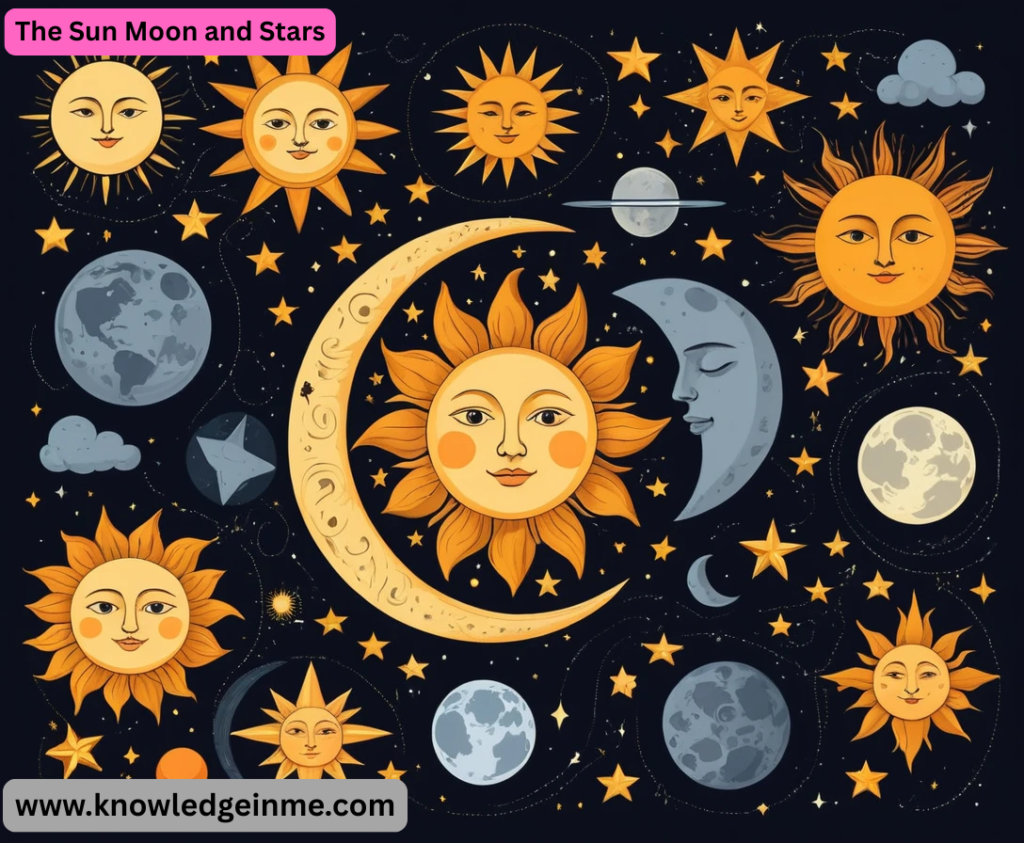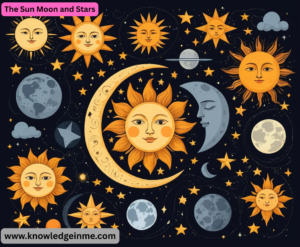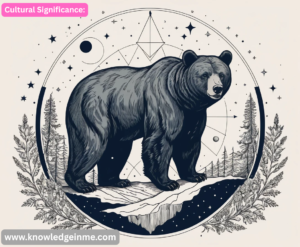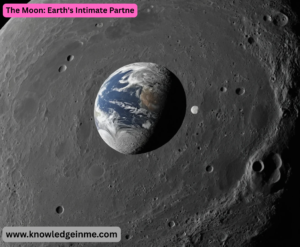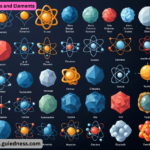The Sun Moon and Stars Of course. The Sun, Moon, and Stars are the most fundamental and awe-inspiring celestial bodies in our sky. They have shaped human existence, from marking the passage of time to inspiring our greatest myths and scientific inquiries. Here is a breakdown of each, from the scientific to the symbolic.
- The Sun What it is: The Sun is a star, a massive, luminous sphere of plasma held together by gravity. It is the heart of our solar system.
Scientific Facts:
Size: So large that about 1.3 million Earths could fit inside it.
- Distance: Approximately 93 million miles (150 million kilometers) from Earth. This distance is defined as 1 Astronomical Unit (AU).
- Energy: It generates energy through nuclear fusion in its core, converting hydrogen into helium. This process releases vast amounts of light and heat, which sustain life on Earth.
- Layers: It has an inner core, radiative zone, convective zone, photosphere (the visible surface), chromosphere, and the outer corona.
Cultural Significance:
Often worshipped as a deity in ancient cultures (e.g., Ra in Egypt, Helios in Greece, Surya in Hinduism).
A universal symbol of life, power, strength, and vitality.
- Its daily rising and setting define our days and nights.
The Moon
- What it is: Earth’s only natural satellite. It is a rocky body with no atmosphere or liquid water.
Scientific Facts:
- Formation: The leading theory is the “Giant Impact Hypothesis,” where a Mars-sized body collided with the early Earth, and the debris coalesced to form the Moon.
- Size & Distance: About 1/4th the diameter of Earth. It orbits at an average distance of 238,855 miles (384,400 km).
- Gravity: About 1/6th of Earth’s gravity, which is why astronauts can bounce on its surface.
- Phases: The Moon does not produce its own light; we see it because it reflects sunlight. Its phases (New, Crescent, Quarter, Gibbous, Full) are caused by the changing angles between the Earth, Moon, and Sun.
- Tides: The Moon‘s gravitational pull is the primary driver of Earth’s ocean tides.
Cultural Significance:
- Often paired with the Sun as a feminine symbol (e.g., Selene in Greece, Chang’e in China).
- Associated with mystery, intuition, dreams, and the subconscious.
- Its consistent cycle (about 29.5 days) is the basis for many calendars and is linked to concepts of time and renewal.
The Stars
- What they are: Massive, luminous balls of plasma, like our Sun, but incredibly far away. They are the building blocks of galaxies.
Scientific Facts:
- The Sun Moon and Stars Formation: Born in clouds of gas and dust called nebulae. Gravity causes clumps to collapse, heat up, and eventually ignite fusion.
- Variety: They come in different sizes (dwarfs, giants, supergiants), colors (red, yellow, white, blue), and temperatures (red is coolest, blue is hottest).
- Constellations: While they appear close together from Earth, the stars in a constellation are often vast distances from each other. These patterns are useful for navigation and storytelling.
- Life Cycle: A star’s fate depends on its mass. It can end its life as a white dwarf, a neutron star, or a black hole.
- Distance: Measured in light-years. The closest star to the Sun is Proxima Centauri, about 4.24 light-years away.
Cultural Significance:
- Used for navigation for millennia by sailors and explorers.
- The basis for astrology and countless myths (e.g., Orion the Hunter, Ursa Major the Great Bear).
- A universal symbol of guidance, hope, and the vastness of the universe.
Their Relationship: A Cosmic Dance
- Their interaction is what creates the rhythms of life on Earth:
- Day and Night: The Earth’s rotation on its axis relative to the Sun.
- Months: The Moon‘s orbit around the Earth (the word “month” is derived from “moon”).
Years: The Earth’s orbit around the Sun.
Eclipses:
- Solar Eclipse: When the Moon passes directly between the Sun and Earth, casting a shadow on Earth.
- Lunar Eclipse: When the Earth passes directly between the Sun and the Moon, casting its shadow on the Moon.
- The Night Sky: The stars are always there, but we can only see them at night when the side of Earth we are on is facing away from the Sun. The Moon’s brightness and phase also determine how well we can see the fainter stars.
The Sun: The Engine of Life
- Beyond the basics, the Sun is a dynamic and sometimes violent place.
- Solar Activity: The Sun has an 11-year cycle of activity.
- Sunspots: Temporary, dark, cooler patches on the photosphere caused by intense magnetic activity.
- Solar Flares: Sudden, massive explosions that release energy equivalent to millions of hydrogen bombs. They can disrupt radio communications and power grids on Earth.
- Coronal Mass Ejections (CMEs): Billion-ton clouds of magnetized solar plasma erupted into space. When directed at Earth, they cause magnificent auroras (Northern and Southern Lights)— a direct, visible interaction between the Sun and our planet’s magnetic field.
- The Solar System’s Architect: The Sun’s gravity dictates the orbits of all planets, asteroids, and comets. Its solar wind (a stream of charged particles) defines the bubble of our solar system, called the heliosphere, protecting us from interstellar radiation.
The Moon: Earth’s Intimate Partne
The Moon’s influence is subtle but constant.
- Synchronous Rotation: The Moon takes the same amount of time to rotate on its axis as it does to orbit Earth (~27.3 days). This is why we only ever see one side of it—the near side. The “dark side” is more accurately called the far side, which receives just as much sunlight but is forever hidden from our view.
- Stabilizing Earth: The Moon’s gravitational pull stabilizes Earth’s axial tilt. This stabilization is crucial for maintaining a relatively stable climate over long periods, preventing drastic shifts between ice ages and extreme heat. Without the Moon, life on Earth might look very different.
- Geological Record: Because the Moon has no atmosphere, weather, or tectonic activity, its surface is an ancient archive, pockmarked with craters that tell a 4-billion-year history of asteroid impacts in our early solar system.
The Stars: Distant Suns and Cosmic History
Every star is a story, and together they tell the history of the universe.
- The Sun Moon and Stars They Are Not Static: The familiar constellations are not permanent. Due to the proper motion of stars through the galaxy, the shapes of constellations slowly change over tens of thousands of years. The Big Dipper, for example, will look different 100,000 years from now.
- Chemical Factories: Stars are the universe’s forges. In their cores, nuclear fusion creates heavier elements like carbon, oxygen, and nitrogen. When massive stars die in supernova explosions, they scatter these elements across space. You are made of stardust. The iron in your blood, the calcium in your bones, and the oxygen you breathe were all forged in the heart of a long-dead star.
- Time Machines: Because light takes time to travel, looking at stars is looking into the past.
- The light from the star Polaris (the North Star) takes about 430 years to reach us. We see it as it was when Galileo was born.
- When we look at the Andromeda Galaxy (a collection of a trillion stars) with the naked eye, we see it as it was 2.5 million years ago.
Their Unified Poetry: A Human Experience
Beyond science, their interplay creates the most profound human experiences.
- The Solstice and Equinox: These are markers of Earth’s journey around the Sun. The Sun’s highest or lowest point in the sky marks the longest or shortest day, celebrated across cultures as a turning point in the seasonal cycle.
- The “New Moon” Sky: When the Moon is a thin crescent or absent from the night sky (near the “New” phase), the darkness allows the faintest stars and the glowing band of our Milky Way galaxy to put on their most spectacular show. This is a direct competition of light between our closest celestial neighbor and the vast cosmos beyond.
- The Pre-Dawn Spectacle: Before sunrise, it’s often possible to see a waning crescent Moon hanging in the sky alongside the brightest “morning star” (which is usually the planet Venus). This quiet moment captures three celestial bodies at once: the approaching Sun (causing the dawn light), the reflective Moon, and a planetary companion, all set against the fading backdrop of the most persistent stars.

